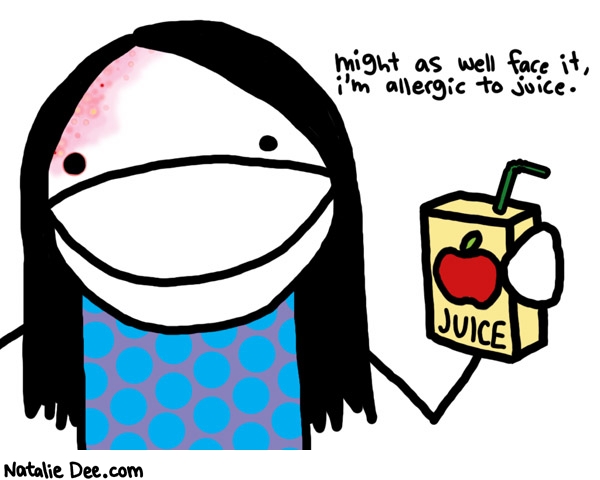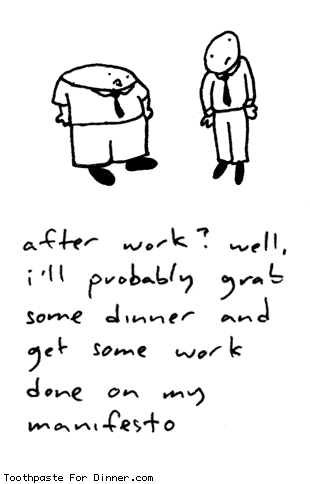Friday, March 31, 2006
Thursday, March 30, 2006
Wednesday, March 29, 2006
Pointless Barking

It may be pretentious, or something, but I will admit it anyway: I love New Yorker cartoons. However, it has been going on for about a year, maybe longer, that on the backpage of the New Yorker magazine there is a cartoon caption contest, where they give you the picture and you're supposed to provide the witticism. You can check it out here. I'm not sure why I'm providing the link for this contest, because what I want to say is, I'm sick of it. It's just never that funny and I become sad, each week, to find that I can't come up with anything good for the caption. But then again, most of the time, nobody does.
However, all this was redeemed when I came across this McSweeney's List:
Future Winners of the New Yorker Cartoon Caption Contest.
BY ROY FUTTERMAN -
"You are doing something unusual, Harold!"
"I certainly am in a bar with other businessmen."
"This desert island is a bummer."
"I love being wealthy in the Hamptons."
"I'm saying a cliché in a different context, Pam."
"Boy, I sure do like intercourse."
"I'm thinking something incongruous to what I'm doing."
"Wanda, we are doing some nutty things in this picture!"
Monday, March 27, 2006
Starting from the womb
This is- I guess- cute in a way, but basically it is a strange trend. I mean, parents can keep far-flung friends and relatives in the loop, and broadcast their love for the child. But from the kid's perspective- I would imagine it would be fun to see baby pictures of yourself and all that, and it's nice to know your parents care a lot about your infantile self, but this particular blogging phenomenon brings it to a weird microlevel that mentions every little stage of development. What happens when your parents have set up a blog for you from day one and then you get to middle school and your crush googles you? It's kind of awkward that they could read about your first burp, hear a podcast of you mispronouncing a word, and see pictures from your first bath.
One post I read on Red Herring, by a blogging parent, had this to say on it:
Is this a good thing? Is the idea that someday the child will take over this blog? Who would want that much of their self on the internet? I mean part of the fun of the internet is the idea that you can reinvent yourself ("on the internet, no one knows you are a dog")-- but that is not an easy thing to do if you have existed on the web before you were cognizant of existence itself.
My efforts to archive my children's lives stand in stark contrast to the scant documentation of my own past. My entire childhood is preserved in just under 200 pictures, a few letters, and a couple of yearbooks: it all fits in a single box. In contrast, I can take 200 pictures of my daughter at a birthday party. At my current rate, each of my children is in danger of having me take 50,000 pictures of them by the time they turn 18. It used to be that only presidents and Nobel laureates had such thoroughly documented lives. Thanks to digital technology, the archive – once a symbol of political power, fame, or wealth – is being democratized.
Anyway, as it turns out, pets can have their own blogs too.
Friday, March 24, 2006
Money, Squash, and Paperclips

I got a terrible feeling this morning: that I was going to look back on this period in my life, in my 60s or something, and kick myself for not getting rich. Perhaps this does not seem a legitimate reason to berate myself- I'm over having missed the dot.com boom. But what is occuring now is the wacky idea boom- the gimmick concept- where if you can come up with an idea that enough people will be motivated to email around or bring up over the water cooler, you are golden.
My prime example is this guy, who started out with a red paperclip and a determination to barter his way up to getting a house. Seriously. To quote him, "My name is Kyle MacDonald and I am making a series of up-trades for bigger or better things up to my goal of a house. I started with one red paperclip on July 12th, 2005." He's currently got a recording contract to trade for something.
But there is also the more modest internet use... the people that find a way and a community online to indulge their personal obsession in a (hopefully) money-making way. Many cartoonists, for example. And also sincere seedsmen. If anyone is in the market for some hard-to-find seeds, why not buy from a man that is not afraid to showcase his love for squash:
"Jeremiath C. Gettle is a young entrepreneur who has a passion for preserving unique and colorful ethnic seed varieties before they totally disappear... Born in September 1980, Jeremiath says that he has been interested in gardening from as early as he can remember. At the age of 4 years, Jeremiath was planting his own garden of scallop squash and yellow pear tomatoes. At age 7, while other children were opening lemonade stands, Jeremiath was producing "play" seed catalogs."
http://gettle.org/
Wednesday, March 22, 2006
What to bring?

For my last class tonight instead of having a regular class, and meeting in our regular classroom, we are having a party. The party will be at another student's apartment (shockingly, I did not volunteer mine, as it could fit approximately 3 people at a time, and one of those people would be standing in the shower). I am overly excited about this party, not necessarily because I think it will be a really fun time, but more because I don't know What it will be like. I realized that I like- in a sort of love/hate relationship way- going into strange social situations. Seeing everyone in my class, which to begin with is an odd mix of people of varied ages and professions, at a random place, with alcoholic drinks available, promises to be pretty damn awkward. Yes.
Now, as part of this shindig, we are supposed to bring something, some food or drink item. This whole bringing something thing has a tendency to (in the same vein as overexcitement) overly stress me out. I think too much on it, I build it up in my head. I feel this weird responsibility to arrive with baked goods even when a bottle of wine would suffice.
For example, for my work Christmas lunch this year I decided to make Rice Krispie treats. Rice Krispie treats are perhaps the ultimate in low key desserts, yet tasty, and would be pretty much ideal in fulfilling my obligation. So the night before the Christmas luncheon I started out efficiently producing typical rectangular Rice Krispie treats, but then, as often happens, I could not leave well enough alone. I thought to myself- well, it is a Christmas party, maybe I should make some snowballs. Then, after a couple of those were satisfactorily executed, I said- well, if I stacked these, I could make snowmen. Then, as long as I am making snowmen, I might as well make a few Christmas trees. Then maybe I'll put sprinkles on all of it... and I'm left with this smorgasboard plate of weird-looking treats dripping with sprinkles. So I'm going to try my hardest to just pick up some wine. We'll see.
Tuesday, March 21, 2006
Dangerous Work
threats and fear were considered part and parcel to the job. Seasoned workers had a repertoire of stories concerning the clients who threatened to kill them/clients who tried to fight them/the situations they walked into
that they should have been walking out of, and more. I heard more than my share of these stories, because it was most fun to share them with green young white new workers- for which I was the poster child.
One story involved a worker that used the two year old child he was holding as a shield from the child's father who tried to attack him. Another tough, large female worker told me a story about running into her client in the
grocery store. In her words, the client got all up in her face, wanting to fight, so the investigator ripped off her own badge and returned the challenge. The client backed off- you would to if you were faced with that particular investigator.
A study released last week by the National Association of Social Workers found that 55 percent of 5,000 licensed social workers surveyed said they faced safety issues on the job. Sixty-eight percent of them said their employers had not adequately addressed their concerns. A survey in 2002 of 800 workers found 19 percent had been victims of violence and 63 percent had been threatened.There was often mutterings about whether we could get "hazardous duty" benefits (like the police have- getting to retire after 20 years) as we were regularly expected to go places and enter situations, alone, that cops did with guns and partners. When I requested to bring another worker along I often got ridiculed by my supervisor, and I also felt like a jerk, dragging a coworker with cases of their own with me to the apartment of a drug-addicted client in the projects who was likely to slam the door in our faces. I had a coworker that resorted to bringing her husband along on some frightening home visits.
The times when workers arranged to do visits in conjunction with the police also proved aggravating. The police often showed up a couple hours after the worker was expecting them, and their role was never clear. About a month after I started the job, I went out with another worker on a domestic violence case. The worker and I were helping a woman move out of her abusive husband's house. I went along to speak Spanish with the woman. The worker and I thought it would be a situation in which we picked up a few bags of her and her baby's stuff and moved on. However, the client had another idea. She took this opportunity to basically strip the house of everything- from the sheets on the bed to the pans in the kitchen cabinet. This took a long time, and was not enjoyable, both because it was 90 degrees outside and she lived on the third floor, and because the abusive husband and 3 or 4 of his male relatives glared at us, the entire time, as we trooped up and down the stairs. On this occasion, a policeman was present- sort of. The policeman sat outside in his car and watched us also, for about an hour, and then he came in and said his shift was over and he was taking off, but the abusive guy that was sitting on the porch, staring us down, would not be a problem. Thanks a lot, we said.
Often, child protective social workers are expected to enter into situations that are comically dangerous; for example, I was supposed to give a ride to court to the client I was bringing into court to testify against in order to remove her children. The client decided not to come to court, thankfully- the possibility of that drive going well would have been a hell of a lot less likely than it ending in violence.
So my question is, why are police awarded for the dangerous nature of their work (and I respect that- they do not have an easy job) and social workers historically not acknowledged? One possibility is that social workers are mainly women, and women often do not receive the pay or benefits men are likely to, nor would the work they are doing be recognized in the same way as perilous. Another possibility is that people do not want to acknowledge the depth and severity of societal problems that require social workers, and in what a dangerous state society is actually in due to those problems.
Friday, March 17, 2006
Thursday, March 16, 2006
Long Vermont Roads

The other day Adam asked me what was the best meal I had ever eaten?
This was an awesome question because it forced me to reflect on many purely positive experiences; to try to determine when delicious food and good company combined to a near-perfect state of a blissful "best meal."
What came to mind was dinner at the Owl in Vermont last summer: chili, fresh mozzarella, tomato, and basil salad, chicken and corn
 on the cob grilled on the fire, beer, smores, wine.
on the cob grilled on the fire, beer, smores, wine.I don't know if I have ever tasted- or will ever again taste- anything as good as that corn on the cob.
The cool thing about this homemade meal is everyone was at work on some part of it, and when we sat down together to eat it, the collective pride regarding the spread about equaled the copious amount of food.
And it was fresh, and it was summer, and why the hell is it back to being cold outside?!
Wednesday, March 15, 2006
Odd-toed Ungulate

Like most red-blooded Americans, I am finding myself thinking about rhinos today.
Top Three Facts:
1. Rhinoceros horns, unlike those of other horned mammals, consist of keratin, densely compacted hair
2. A group of rhinoceros is called a "crash"
3. The horn of the Rhino is not attached to the skull

"The Rhinoceros" (1515), by Dürer. In 1515 the German artist Albrecht Dürer made a woodcut of a rhinoceros, an ominous-looking creature with a sharply pointed horn on its snout. It wore a duded-up suit of armor from which emerged four scaly legs with cloven feet. Dürer had never seen the real thing; neither had most other Europeans. But his widely distributed image, conjured up from descriptions of an actual beast given to King Manuel I of Portugal by the governor of his Indian territories, was accepted in Europe for more than 200 years. It even inspired part of the design for a bronze door at the cathedral of Pisa in 1602. (The real rhinoceros, dispatched as a gift to Pope Leo X, could not serve as a reality check because it went down with the ship transporting it to Italy.)I think it is pretty amazing Durer came up with the woodcut above without ever having laid eyes on a rhinoceros. Well, at least I think it is impressive. Come to think of it, I've never laid eyes on a rhino either. For all I know the existence of rhinoceros could be an elaborate hoax, a crazy conservation money scheme.
I do think there should be more in the way of elaborate hoaxes.
But anyway, in my thinking about rhinos, I did find that "rhinomania" was enjoyed in Europe in the eighteenth century due to an early marketing campaign. There is a book about it titled CLARA'S GRAND TOUR: Travels with a Rhinoceros in Eighteenth-Century Europe by Glynis Ridley. Apparently, according to one review, "fashionable people started to accessorize their hair, clothes and carriages a la rhinoceros, using
feathers and ribbons to simulate Clara's body parts." Book summary:
For nearly 20 years in the mid-1700s, a 3-ton Indian rhino named Clara
traveled Europe--from Rotterdam to Breslau, Naples, Marseilles, and many
places in between. Making this an even more amazing achievement is that
it happened before railways and modern roads existed. Clara, orphaned
when she was only months old, was hand raised by a Dutch merchant in
Assam, India. When she was 3 years old, a Dutch sea captain brought her
to Europe. There, she became a sensation. In one of the first marketing
campaigns of all time, her owner promoted Clara's appearances to
peasants and royalty alike. Both came to see her. There were Clara
product tie-ins galore: poems, songs, fashions, portraits, etchings, and
bronze figurines. Her image adorned everything from tin coins to fine
porcelain, and a fortune for the Dutch captain.
Friday, March 10, 2006
Smells like Spring!!!!!!!
Today
by Billy Collins
If ever there were a spring day so perfect,
so uplifted by a warm intermittent breeze
that it made you want to throw
open all the windows in the house
and unlatch the door to the canary's cage,
indeed, rip the little door from its jamb,
a day when the cool brick paths
and the garden bursting with peonies
seemed so etched in sunlight
that you felt like taking
a hammer to the glass paperweight
on the living room end table,
releasing the inhabitants
from their snow-covered cottage
so they could walk out,
holding hands and squinting
into this larger dome of blue and white,
well, today is just that kind of day.
Neon Bunny/Blue Cat: You Decide

‘Alba’ is a transgenic albino rabbit: She contains a jellyfish gene that makes her glow green when illuminated with the correct light. Alba was created by French scientists who injected green fluorescent protein (GFP) of a Pacific Northwest jellyfish into the fertilized egg of an albino rabbit.What is art? is perhaps a question that has been asked enough times to seem pretty trite. I think a better question for our day and age is what is the line between art and science? As science gets wackier and more impressive, various robotic things and genetic twists and outer space images are more stunning, innovative, and thought-provoking than a lot of "art."
The ability to manipulate technology has rapidly become more important to visual artists, musicians, photographers, filmmakers than a lot of the classic tools involved with these trades. Artists on the cutting edge are pairing up with scientists and making other's scientific know-how and work into their own art.
This brings me to the rabbit above. The living rabbit, named Alba, was a piece by Eduardo Kac called Transgenic bunny. Wikipedia has this to say on it:
My junior year of high school my friend Jaime and I were bored one day after school and we dyed a blue streak- like a skunk's- down the back of my aged cat, Mousey. She did not like it too much, but we thought it was pretty funny... lucky for Mousey, though, she did not have to live out her days in a lab after this experiment. If she had though, you can bet I would still be flying her flag high!Kac considers himself a "transgenic artist," using biotechnology and genetics to create provocative works that concommitantly revel in scientific techniques and critique them. In what is probably his most famous work, GFP Bunny, Kac collaborated with a French laboratory to procure a green-fluorescent rabbit; a rabbit implanted with a GFP (Green Flourescent Protein) gene from a type of jellyfish. Under certain blue light, the rabbit fluoresces green. Kac's wife and daughter helped name the rabbit, Alba. After a brief stint as an installation work, wherein Kac and Alba would live in a pseudo-domicile in a gallery, Alba was to return home to Evanston to live with Kac's family. At the last minute, before the scheduled release of Alba to Kac, the lab retracted their agreement.
Alba ostensibly died prematurely in the lab, of unknown causes. The death raised some interesting questions, including that of Alba's age (in relation to the premature nature of the death), causing some to question whether Kac was actively involved in the creation of the GFP Bunny, or whether he merely "purchased" a specimen already planned and/or living at the lab. GFP plants, fish, and mammals have, in fact, been long-term residents of science laboratories. The GFP gene is typically used as a type of marker, that, when attached to a separate genetic modification or gene, illustrates where that symbiotic gene manifests in the organism. Notably, since Alba's conception, GFP zebrafish have hit the commercial market under the trademarked name, GloFish(tm).
Kac, in response to the lab's retraction of Alba's liberty, flies a flag outside of his home, sporting a silhouette of a green rabbit. Apparently, this is the transgenic artist's version of keeping the porch light burning, so to speak.
Friday, March 03, 2006
Fido Luggage

This may be the coolest thing I have ever seen:
Fido Luggage.
A robot piece of luggage that you don't have to worry about dragging around, because it follows you.
Whoa.

Fido Luggage appears, at first glance, to be remarkable only because of its colorful exterior and blob-like shape. But then you might notice it has a tail. And that it moves on its own, heels beside its owner, and changes direction on command. The owner wears a wristband, which holds an on-off switch for activating Fido, and a receiver for programming voice recognition. And in ways that only a robot can be superior to a dog, even when Fido gets old, you can still retrain it to respond to new commands.
I watched The Jetsons. I felt they had a lot to offer the future. Yet I have been feeling since maturity struck that there is something lacking in this world- I'm speaking of the void left by slowly developing robotics. Where are the helicopter cars? Why don't I have a robot? Where's the new ease of life technology has brought on? Well this luggage assuages all those concerns in one fell swoop.
Also, that link to the Jetsons found me reading episode's synopsis from the 60s on. Please note I have nothing at all to do at work. Anyway, there were a few that I thought might help us navigate a world that includes more robots:
New York Notes

Things I like:
1. deli flowers on the street
2. the lack of ordinary
3. hummus availability
4. the vague Frankenstein-like look in the eyes of commuters
5. overhearing conversations

Things I dislike:
1. overpriced drinks
2. lack of stars
3. crowdedness of every damn starbucks
4. the vague Frankenstein-like look in the eyes of commuters
New York Notes
by Harvey Shapiro
1.
Caught on a side street
in heavy traffic, I said
to the cabbie, I should
have walked. He replied,
I should have been a doctor.
2.
When can I get on the 11:33
I ask the guy in the information booth
at the Atlantic Avenue Station.
When they open the doors, he says.
I am home among my people.
Wednesday, March 01, 2006
Also Avoid Strainers

According to this enlightening article, I, as a Taurus, am supposed to avoid the following things this month:
Taurus (April 20 - May 20)
You might have a hard time getting up in the morning or making a quick decision, Taurus, but once you get going, nobody can stop your forward motion. You love what you love, and there's no arguing with you about it.
What to avoid: Ugly objects; fake environments; quick showers; scratchy clothing; flirty partners; forced change; windowless offices; fast-food jobs; nagging mothers.
Your survival pack: A flush wallet; a chia pet; a chamois scarf; well-fluffed pillows; a faithful lover; a drive in the country; aromatherapy bubble bath; your favorite collection.
However, like all great literature, this piece leaves me with questions as well as answers: How am I to avoid fast-food jobs? And what is a chia pet doing in my survival pack?

